Advanced Turning
Factors affecting chip control
It can be seen that the “h” section of workpiece material has changed considerably to a much thicker shape (hc) possibly because the workpiece material continuously suffers from shear deformation and accumulates as shown. The fact that such plastic deformation actually occurs has been proved by various tests.
In the process of shear deformation, high heat is generated by internal friction. This is why chips are too hot to be handled manually even if the cutting speed is low. Additionally, work hardening occurs making the chips much harder than the workpiece material itself.
- Click the links below to
read more!
The animation to the right shows a turning tool machining a workpiece. When the depth of cut is h, the chip thickness is approx. 3h. The workpiece cross section marked with diagonal lines, h×l, was machined by the cutting edge and transformed into a chip. This created a chip thickness of approx. 3 times×h and the length was reduced to about 1 / 3 with the same cross section. This demonstrates that the metal underwent great deformation in the process of being made into a chip.
In general, when cutting speed increases, the chip control range tends to become narrower. The figure to the right shows the chip control range at various cutting speeds.
In the high-speed, low-feed area (shown as A in the graph), the chips have not been broken and tend to be continuous. This is because as the cutting speed increases, the chip temperature rises and causes the chips to become more malleable and therefore flow smoothly, the cutting ratio (hc / h) decreases, chips become thinner and effective chip breaking becomes difficult.
Rollover the buttons below for more information!
Cutting speed and chip control range of chip breaker
vc=50m/min
vc=100m/min
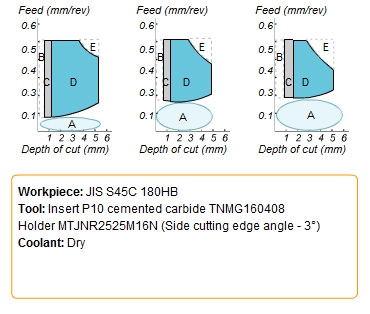
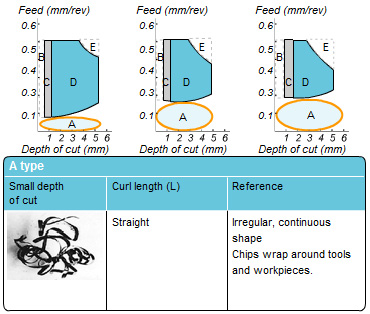
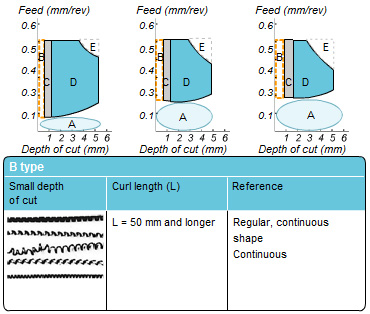
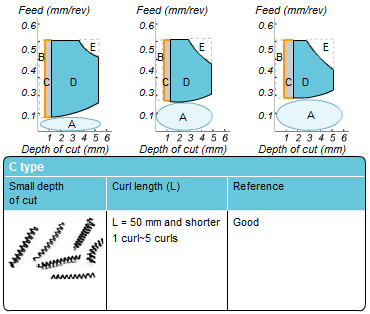
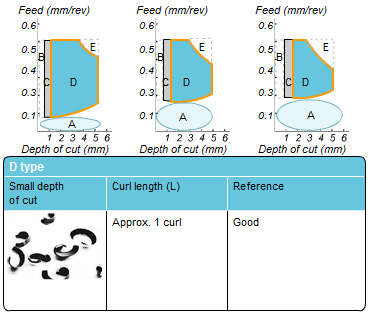
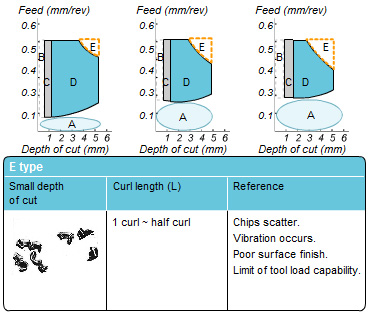
A
B
C
D
E
vc=150m/min
If the cutting speed is the same, the range of chip control differs according to whether coolant is used or not. The image to the right shows the difference in the range of chip control when machining a carbon steel at 100m / min. with or without coolant. With coolant, the effective range of chip breaking becomes wider, this is because the chips are cooled rapidly, become hard and thus become easier to break.
Effects of coolant on the chip control range of a chip breaker.
Coolant: Dry
Coolant: Wet (emulsion)
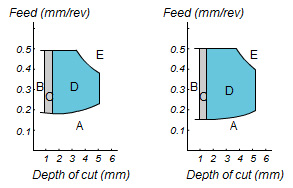
Workpiece: JIS S45C
Cutting condition: vc = 100m / min
As the lead angle increases, chip control deteriorates. The figure to the right shows the difference in thickness of the chip when the lead angle is 0°, 15°and 30°. As the lead angle increases, the thickness of the chip, h, becomes thinner and the chip length increases. Additionally, the chip curl radius becomes larger and the chips are not as easily broken. This is the same result as when the depth of cut is increased and the feed is decreased.
Click the buttons for more information!
Change in chip thickness for various lead angles.
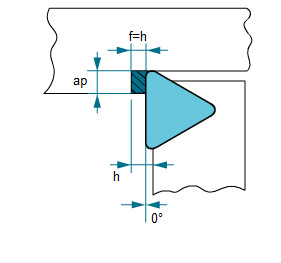
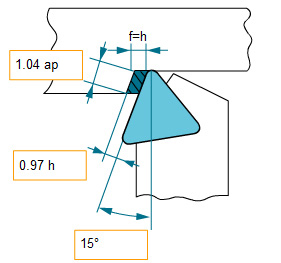
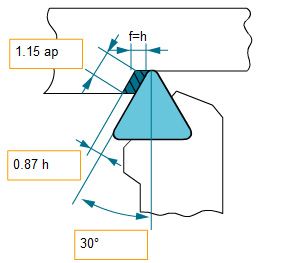
0°
15°
30°
In general, a larger corner radius tends to worsen chip control. This tendency can be especially seen at low depths of cut. This is because with a large corner radius, the curved part of a chip section becomes larger and thereby the actual side cutting edge angle increases. As written above, with a larger lead angle, the width of cut becomes thinner, the chip width and curl radius become larger and the chips are less easily broken.
Relationship between corner radius and chip thickness.
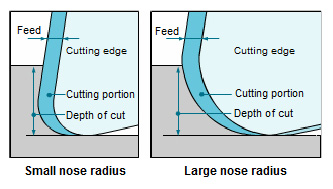
A smaller rake angle creates thicker chips and enables them to be curled and broken easily. The animation to the right shows the chip thickness with different rake angles. With a small rake angle, the shear angle ø becomes smaller and therefore the chips are thicker and easily broken. With a large rake angle, the shear angle φ becomes larger, the chips become thinner and tend to be continuous.
Relationship between rake angle and chip thickness.
Cutting speed
Coolant
Lead angle
Corner radius
Rake angle
x